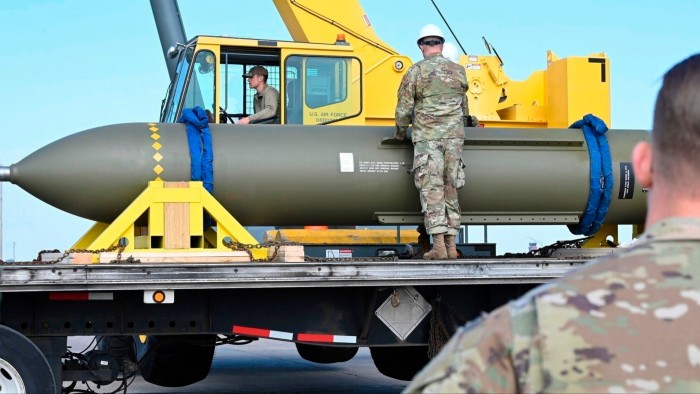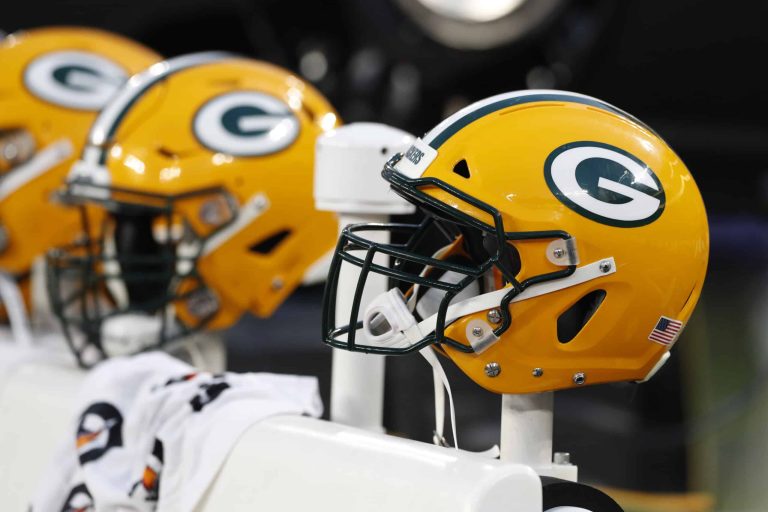Should the US enter the conflict between Israel and Iran, it would be expected to play a key role in destroying Iran’s underground uranium enrichment facilities.
That task would almost certainly fall to a select number of US bomber planes that are big enough to deliver a 30,000lb precision-guided bomb, known as the GBU-57 E/B Massive Ordnance Penetrator, or MOP — the world’s most powerful non-nuclear bomb.
Dropped from a B2 stealth bomber, the 6m-long MOP can reportedly penetrate with sheer kinetic force more than 60 metres of rock and soil — depending on the earth’s hardness — before exploding. Because it is precision-guided, multiple bombs can in theory be dropped on a single spot.
That gives the MOP, which is more powerful than any known conventional bomb in Israel’s arsenal, potentially enough impact to destroy much of Iran’s underground enrichment facilities, especially the Natanz site, which is thought to be buried 20 metres underground and encased in some 2 metres of reinforced concrete.
However, it may not be enough to destroy the more-heavily protected Fordow facility, which is buried inside a mountain under as much as 80 metres of rock and soil — even though the bomb was developed for that specific purpose.
Rafael Grossi, head of the International Atomic Energy Agency, has said that some of Fordow’s most sensitive facilities may be buried even deeper, as much as half a mile underground.
“I have been there many times,” he told the FT this month. “To get there you take a spiral tunnel down, down, down.”
The lack of any guarantee that a successful bomb strike, or even a series of strikes, would destroy most or all of any already enriched nuclear stockpile in Fordow recalls a similar predicament faced by the US in the past.
When the US was contemplating a pre-emptive bombing campaign against Soviet nuclear weapons stationed in Cuba during the 1962 Cuban missile crisis, a key concern was a potential failure to destroy all the targets — a risk calculus that prompted President Kennedy to opt for a naval blockade and diplomacy instead.
“The US Air Force were only confident that they could destroy 85 per cent of the targets — which is why there were also plans for a follow-up ground invasion,” said Robert Pape, a US military historian and author of Bombing to Win, a landmark survey of 20th century bombing campaigns.
“In the Iranian case, how can the US National Security Council be sure that they are going to get everything? That is the big issue,” he said.

Manufactured by Boeing, the MOP has been tested at the White Sands Missile Range in New Mexico but has never been used in active combat. That potentially introduces a second problem.
“To destroy Fordow, which the MOP was explicitly designed for, would probably take at least two bombs, each hitting exactly the same spot,” Pape said.
“That may be fine, and I am sure the US Air Force has the technical capabilities. But it’s never been done before in a real war.”
The MOP’s 22,000lb predecessor, the Massive Ordnance Air Blast or MOAB, colloquially known as the Mother of All Bombs, was less powerful but was used to devastating effect in Afghanistan in 2017. It was dropped on a cave complex operated by an Islamic State affiliate in Nangarhar Province.

The MOP — which was developed from 2002, first deployed in 2011, and periodically upgraded since then — is an improved and more targeted version of the MOAB: its explosive charge is bigger and is carried inside an extremely rigid metal casing that allows for penetration before explosion.
The US arsenal is thought to contain about 20 MOPs. Each bomb costs about $4mn, based on a 2011 $28mn US Air Force contract for eight of them.

Only the B2 Spirit Stealth bomber is configured to carry and deliver the MOP. There are 20 B2 bombers in service, according to the US Air Force, each of them capable of carrying two MOPs, one in each of its bomb bays.
The bomber, made by Northrop Grumman, has an unfuelled range of 11,000km, or 19,000km with one mid-air refuelling — making almost any target in the world reachable.
Despite the fearsome capabilities of both the MOP and B2 bomber, any mission to destroy the Fordow plant would face other tactical difficulties, Pape said.
The first is that to drop more than one bomb on the facility might require the B2 bomber to loiter above its target, becoming vulnerable to Iranian air defences.
“The B2 is a stealth bomber, but it’s designed to avoid radar — it’s not stealthy in every aspect,” Pape said. “For example, it has a very flat bottom — which can make it as vulnerable as a 737 plane to anti-air missiles.”
The second challenge would involve clearing a safe flight path for the B2 bomber to its target. That could be done by using anti-radar cruise missiles that could take out any Iranian radar installations that Israeli forces have not already destroyed.
“But Iran may well have anticipated the US cutting such a corridor,” Pape said. “The bombing raid may well work — but it would need to be embarked on knowing that it has never been done before.”
Additional graphics by Gaku Ito







